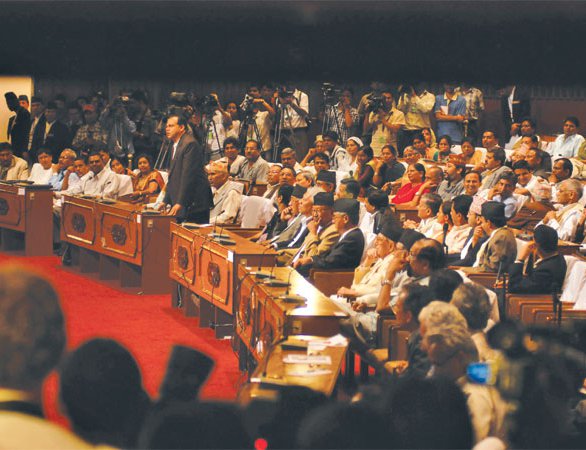
An experienced expat once kindly remarked that Nepalis love grand ritualistic form over meaningful substance which they often distain as petty, and that this is why foreigners find the country so Shangrila-esque and quaint. As a guest, he was being very diplomatic: Nepalis themselves have a much more rude expression to describe this pathology – syal ko huinya, the unison howling of canines after one begins to bay. The proof of this is the current non-discourse over elections.
A year after the ignominious collapse of the Constituent Assembly (CA), the country is still on its politically rudderless drift, and nary a ‘Land Ahoy!’ on the horizon. All the main parties are now further apart on major issues than in 2006, more distrustful of their former ’12-point Delhi deal’ comrades-in-arms, less willing to bank on the peoples’ verdict and hence more fearful of elections. They are also seeing a growing rift between their top leaders and their rank-and-file. Furthermore, having given up the right to lead a caretaker government for election purposes, they know they have little chance of misusing the government funds and machinery during elections; but, given that the loyalty of ex-bureaucrats newly become ministers is suspect, they are not so sure their opponents won’t. And yet dutifully the party oligarchs keep mouthing, and a highly partisan corporate media loyally parrots, that they are all for election, that it will happen, that election is the salvation for Nepal and the solution to all ills faced by the country. One gets the surreal feeling that the hardly dozen or so party oligarchs that the media continue to lionize think the CA of yore still exists, and why not? After all it “existed” as a zombie well past its two-year mandated life, serving them and their patronage dispensing so well, and letting them off scot-free from having to answer difficult questions. Why should they be faulted for living under the happy illusion that the façade is still “there”?
It is said that the hardest thing to do is to convince others when you yourself are not convinced of what you are saying. That and also to try and awaken someone who is only pretending to sleep. And this pretense comes through loud and clear. The Nepali public is very skeptical today because it has heard similar mass baying by the political coyotes before:”CA is a once in a lifetime event”; “CA is the ultimate salvation for Nepal”; “Consensus is just around the corner”; “Eighty percent of the constitution is already made”; “Federalism will forever assure absolute inclusiveness”; and so on. Consider the last one which is the overt issue on which the CA collapsed. Nepalis want decentralization and local government that serves their everyday need, not an undefined, half-baked federalism which will tear apart mixed communities that have been living more or less peacefully over the centuries. No party was able to define what that federalism was and how major groups such as the Dalits and hill castes would be accommodated. Even more shameful, no major party advocated strengthening local bodies and speedily holding local elections to municipalities, VDCs and the districts. Highly personalized, a step higher than even ‘centralized’, the parties and their reigning oligarchs saw the possibility of new and younger leadership emerging from such decentralization as a threat to their positions. No democrats these oligarchs, why would they want elections that may displace them in May or November or any other time?
It is not what they say but what they do that proves this point. Look at the recently concluded Nepali Kangress’s Mahasamiti meeting. It was unable to decide any policy line on any major issue facing the country’s politics which would convince its large support base of now quite apathetic voters to go out and vote for the grand old democratic party. On the contrary, keen observers saw plenty of indications that the vast majority of its members have distinctly recognized that the party made a big mistake in becoming the political porters of the Maoists in 2005. The CA was a bad and impractical idea, a sentence implanted by the Mughlani handlers into King Tribhuban’s speech in February 1951, which BP Koirala and King Mahendra had, in their sagacity, done away with in 1958. The collapse of the CA in May 2012 was just another proof that these two towering nationalists were right then and continue to be right today. Going for another CA without first asking why the old one failed and taking corrective measures to make sure those factors, including incompetent individuals are eliminated, is tantamount to repeating history, this time around as a farce.
Similarly, getting rid of the country’s age-old cultural identity by declaring it secular without permission from the people seems to be weighing down the Kangressis with guilt, fear and trembling about what their erstwhile voters might say if they went for elections. Hence the need felt by the party oligarchs to trot out a Hindu swami as chief guest during the inauguration of Mahasamiti. It would have been politically more honest and praiseworthy had the party debated that issue, put it to a vote and gone to the people with a firm conviction as party line. That political courage was totally lacking in the Kangress, and is absent in the UML and Madhesi leadership as well. The Maoists, especially of the Cash variety, speak with so many tongues it is impossible to say what the party stands for other than the aggrandizement of its oligarchs.
The Kangress Mahasamiti meet on the Gandak in Nawalparasi was remarkable on several other counts. It was so badly organized that an estimated thirty to sixty percent (depending on whom one talked to, the establishment or the dissidents) of the members did not bother to stay back for policy discussions the next day. The given reasons were that there was not even proper drinking water supply or food or sleeping arrangements and mosquito repellants. The implied reasons were that the party leadership had no courage to “let a thousand flowers bloom” through free and frank discussions about the mistakes of the party over the last half dozen years and how to correct them. How, a voter might ask, can a party that could not supply drinking water to its delegates or manage a meeting of a few thousand people manage the country?
The remarkable “achievement” of the Kangress Gandak meet was its belated by half century education on water resources. It seems many of the delegates took the opportunity to visit the Gandak barrage and see for themselves how Nepali farmers are suffering with its mismanagement, how Nepali lands at Susta are being encroached upon and so on. Because this was a treaty done by BP Koirala, they felt they had to sing its praises and close their eyes to its malevolent impact on Nepal and the miasmic rancor it has left behind that prevents Nepalis from believing that such treaties with the Mughlanis can be beneficial to Nepal. Had the Kangress bothered to even acknowledge the concerns of the farmers of the Gandak water users association, who have been agitating for the decades, they would have graduated into reality ages ago and not fallen headlong into the mistakes of Tanakpur-Mahakali in 1996 or with the Arun and Karnali after the regime change in 2006. However, this time on the banks of the Gandak the Kangressi members got a personal education that did not translate into any kind of collective party wisdom on this vital issue.
The closing of eyes towards real substance and making merry with illusory forms is not limited to parties only. At a recent jamboree of the FNCCI, the businessmen of Nepal got leaders of Nepal’s major political parties on the podium to sing paeans to a declaration on water resources promising not to make water projects a subject of political debate. Those parties such as the Dash Maoists, RPP-N or the Janamorcha that have been asking relevant questions about the dis-benefits to Nepal and its consumers from these bad projects were either not invited or did not bother with the sham. The CA, into which most of the worthies of FNCCI had been nominated by all major parties, was unable to pass an electricity act to address the very issues mentioned in the declaration; and FNCCI has not had the courage to ask why. If it could not be done in the CA, how would it done by dancing to a declaration on a hotel podium?
As the Stockholm water prize laureate Tony Allan asks, how is water the stuff of life if it is not political? One must ask of Nepal’s political parties an even more remarkable question: how is election the lifeblood of politics when its basic substance – election for what, how, with what voters, for which form of representation, and to do what – has been taken out of the debate and replaced by a syal ko huinyan?

Dipak Gyawali
Gyawali is Pragya (Academician) of the Nepal Academy of Science and Technology (NAST) and former minister of water resources.
- Re-Thinking Democracy: Why South Asians Are worried
- Mar 17, 2025
- Nepal’s Governance Mired In Endemic Corruption
- Feb 20, 2025
- What Might The Age Of Trump Look Like?
- Jan 22, 2025
- Kathmandu Dialogue With Dugin
- Dec 25, 2024
- Bioregionalism Satsang
- Sep 27, 2024














